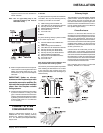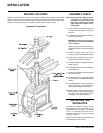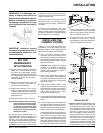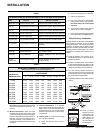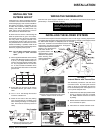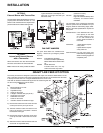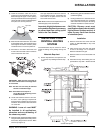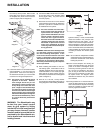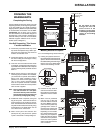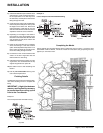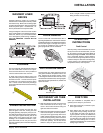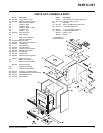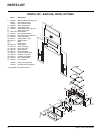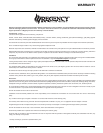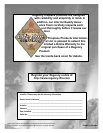
Regency Z2510 WarmHearth20
MAINTENANCE
MAINTENANCE
Gold Plated Doors and Louvers
The optional gold electroplated fi nish on the
doors and louvers requires little maintenance
and needs only to be cleaned with a damp cloth.
DO NOT use abrasive materials or chemical
cleaners, as they may harm the fi nish and void
the warranty. Keep doors and louvers off during
construction to avoid damage.
Door Gasket
If the door gasket requires replacement, your
must use 7/8 in. dia. oval, high density mate-
rial, 6-1/2 ft. long. A proper high temperature
gasket adhesive is required. Contact your
dealer for the Regency Gasket Repair Kit,
Part # 846-570.
Door Hinges
Grease door hinges with high temperature
grease regularly for smooth operation and to
avoid squeaks.
Glass Cleaning
Only clean your glass window when it is
cool. Your local retailer can supply you with
a recommended glass cleaner if plain water
and a soft cloth does not remove all deposits.
Do not use oven cleaner on the glass as it will
etch the glass.
Glass Removal/Replacement
Allow the stove to cool before removing or
replacing glass. Remove the door from the
insert and remove the glass retainer. Use
caution when removing broken glass to avoid
injury. When placing the replacement glass in
the door, make sure that the glass gasketing
will properly seal your unit. Replace the retainer
and tighten securely, but do not wrench down on
the glass as this may cause breakage. Do not
substitute materials. If your glass door breaks,
do not use your unit until it has been replaced
(refer to Glass Installation section).
CAUTION: Never leave unit unat-
tended if door is left open. This
procedure is for fi re start-up only,
as unit may overheat if door is left
open for too long. The door is to
be opened for a maximum of 5 min-
utes while loading or for ignition
purposes only.
3) With the draft still in the fully open position
add two or three seasoned logs to your fi re.
Form a trench in the ash bed to allow air to
reach the rear of the fi rebox prior to closing
the door.
4) During the fi rst few days it may be more
diffi cult to start the fi re. As you dry out
your fi rebrick, your draft will increase.
Due to the large quantity of fi rebrick, which
has a high water content, it may take many
fi res (20 or more) to thoroughly cure the
fi rebrick. The fi rebrick will become lighter
in colour as it dries out.
5) After about 15 to 20 minutes, when your
wood has begun to burn strongly, adjust
your draft control down to keep the fi re at a
moderate level.
WARNING: Never build a roaring fi re in
a cold stove. Always warm your stove
up slowly!
6) Once a bed of coals has been established,
you may adjust the draft control to a low set-
ting to operate the unit at its most effi cient
mode.
7) For the fi rst few days, the stove will give off an
odour from the paint and oil burn off. This is
to be expected as the high temperature paint
becomes seasoned. Windows and/or doors
should be left open to provide adequate
ventilation while this temporary condition
exists. Burning the stove at a very high
temperature the fi rst few times may damage
the paint. Burn fi res at a moderate level the
fi rst few days.
8) For those units installed at higher elevations
drafting problems may occur. Consult an
experienced dealer on methods of increasing
your draft (refer to the Flue Height Chart).
9) Some cracking and popping noises may be
experienced during the heating up process.
These noises will be minimal when your unit
reaches temperature.
10) Before opening your door to reload, open
draft fully for approximately 10 to 15 seconds
until fi re has been re-established. This will
minimize any smoking.
12) Green or wet wood is not recommended
for your unit since most of the energy will
be used to drive off the moisture instead of
heating your home. As well, green or wet
wood can result in dirty glass.
13) Always maintain clean glass. Clean glass
means a clean fl ue; if you are experiencing
dirty glass you may be operating a fi re that
is set too low. Ask your dealer for details.
14) Keep your spark arrester on the fl ue clean. It
should be checked and maintained regularly,
at least monthly.
SAFETY GUIDELINES
1) Never use gasoline, gasoline type lantern
fuels, kerosene, charcoal lighter fuel or
similar liquids to start or ‘freshen up’ a fi re
in your fi replace. Keep all such liquids well
away from the unit while in use.
2) Keep the door closed during operation and
maintain all seals in good condition.
3) Do not burn large quantities of paper in your
fi replace.
4) If you have smoke detectors, prevent smoke
spillage as this may set off a false alarm.
5) Do not overfi re fi replace. If overfi ring takes
place, stop adding fuel and close the draft
control. Overfi ring can cause extensive
damage to your unit including warpage and
premature steel corrosion. Overfi ring will
void your warranty.
6) Do not permit creosote or soot build-up
in the chimney system. Check and clean
chimney at regular intervals.
7) The fi replace face can be very hot. You
may be seriously burned if you touch the
unit while in operation. Warn children of
the burn hazard.
8) Do not connect this unit to a chimney fl ue
serving another appliance.
9) Do not use grates or andirons or other
methods for supporting fuel. Burn directly
on the bricks.
10) When refuelling the fi re turn off blowers, open
draft prior to slowly opening the door. Failure
to do so could result in smoke spillage.
11) Your unit should burn dry, standard fi rewood
only. The use of “mill ends” is discouraged as
this fuel can easily overheat your fi replace.
Evidence of excessive overheating will void
your warranty.
As well, a large portion of sawmill waste is
chemically treated lumber, which is illegal
to burn in many areas. Salt drift wood,
chemically treated fi re logs and pressure
treated woods must not be burned in your
woodstoves.
12) Do not store any fuel closer than 2 feet from
your unit.
13) IMPORTANT: Do not obstruct the convec-
tion louvers at any time. Blocking air into
this area will cause excessively high fi rebox
temperatures and a potentially dangerous
situation.
11) All fuel burning appliances consume oxygen
during operation. It is important that you
supply a source of fresh air to your unit while
burning.



